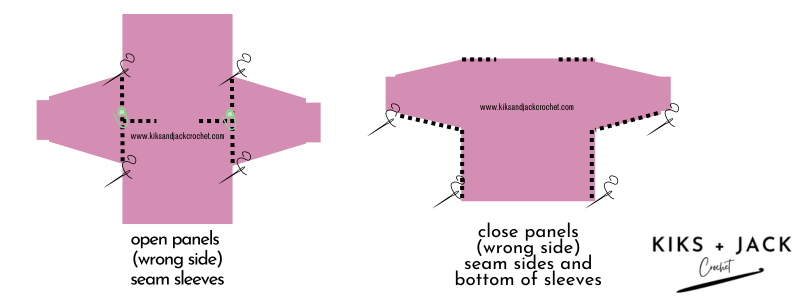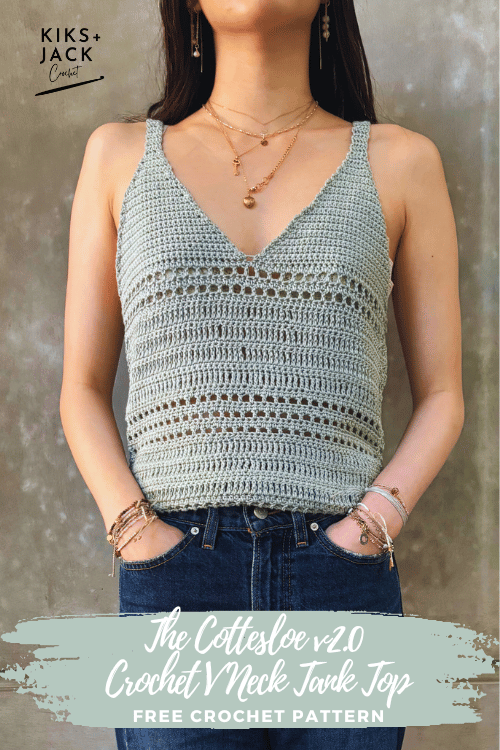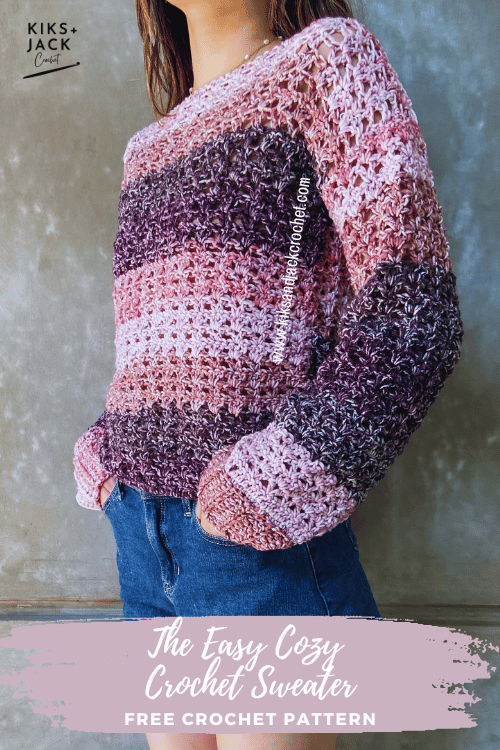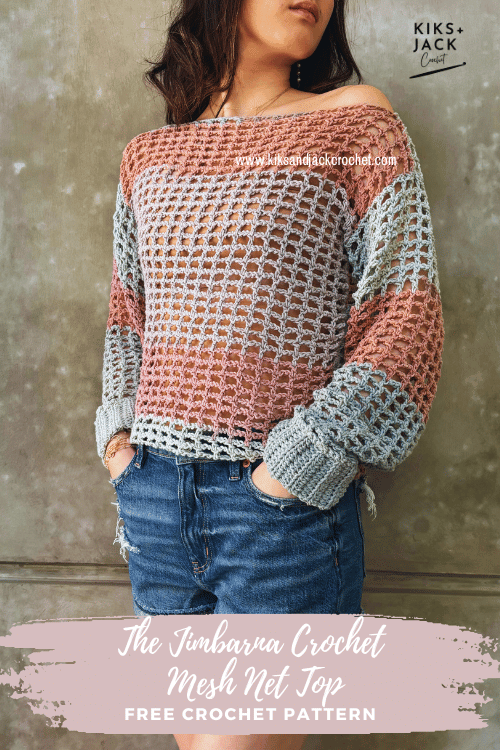The Eve Simple Spring to Fall Crochet Sweater is a free and easy crochet pattern that is made to measure, and size inclusive. It is designed and written specifically for beginners.
We find the crochet garments that we reach for every day, are often the most simple and basic. It’s our style – simple stitches and basic construction. As much as we love to crochet intricate granny squares with multiple stitching and multiple colour changes, we find we actually reach for the crochet basics as we run out the door. The simple, oversized crochet tee, the slouchy chunky crochet cardigan and a well stitched but basic pullover.

We are trying to keep all our crochet patterns free for everyone, when you access them online. We meet the costs of running this website through coffee donations at https://ko-fi.com/kiksandjackcrochet and ad revenue. When you buy us a cup of coffee, you buy us a cup of motivation. Thank you for keeping us motivated and inspired every day to keep designing free crochet patterns for you.
The Eve Simple Spring to Fall Crochet Sweater is a personal project – meaning we genuinely just wanted something like it in our wardrobe – and we didn’t want to buy it. We have mentioned “Personal Projects” before like The Quinn Fast Summer Crochet Tank, and you will probably find they are the most basic of our designs. When these projects are completed we decided to post it here, because we thought you may like it too!
Initially we wanted to wear this in the cooler weather and thought it through in spring. Unfortunately we didn’t get it finished in time and now it’s a little too hot! However we know we will wear it as the temperature drops again in the crisp fall. That’s why we called it the Simple Spring to Fall Crochet Sweater.
We knew immediately that we wanted to use this yarn from Lion Brands. Although we knew this yarn was going to give beautiful drape we designed it with the bead stitch and the triple crochet to give it even more drape. You can find all the details in the section Crochet Materials below along with a few substitutions.
In terms of the neckline, we kept it as a simple scoop neck. We could have added a ribbing, but we loved the basic neckline. We did add a ribbing on the bottom of the sleeves to give it a slightly more polished look but we kept it off the base of the sweater.

This is a pattern perfect for the crochet beginner or advanced crocheter that jut want something simple, basic and beautiful to wear! Nothing fussy and super easy to wear. Just beautiful stitching by you to create a gorgeous modern crochet top.
Let’s get started on the Eve Simple Spring to Fall Crochet Sweater!
Follow us on social media for updates on free crochet patterns and tag us your work in progress by clicking on the icons below:
DESCRIPTION of the Eve Simple Spring to Fall Crochet Sweater Top
The Eve Simple Spring to Fall Crochet Sweater is a casual top and light sweater that can be worn from spring to fall (we plan to wear it in winter too under crocheted cardigans). It features a slightly oversized design and long sleeves with ribbing on the sleeve cuffs. The neckline is scoop neck and customizable to be wider or more narrow. The stitches used to create the main panels are simple and beginner friendly. There are three stitches used; the basic half double crochet, triple crochet and the bead stitch.
The Eve Simple Spring to Fall Crochet Sweater is a free and easy crochet pattern available as a size inclusive made to measure pattern. It is designed and written specifically for beginners.
CROCHET MEASUREMENTS & SIZES
The Eve Simple Spring to Fall Crochet Sweater pattern instructions are made to measure, based on your required measurements.
Kiks + Jack Crochet will always try to write patterns that are “made to measure” (versus graded sized patterns) so that crocheters can get the wonderful benefits of making a garment that fits perfectly. However we do appreciate taking measurements can be inconvenient for some and have also provided standard measurements for those who wish to use it.
To use this pattern you will need the following measurements and you should write them down for easy reference:
Chest/Bust: Measure around the fullest part of your chest/bust. Do not draw the tape too tightly.
Finished length: Measure from your hipline (or where you would like the top to end) up to the top of your shoulder.
Arm Length: With arm slightly bent, measure from armpit to wrist (or where you would like the sleeve to end)
Wrist Circumference: Measure from one point on your wrist all around your wrist.
Upper Arm: Measure around the widest section of the upper arm located above the elbow
Standard Sizing (For Reference)
If you would like to use standard sizing for the chest/bust – then for XS (S, M , L, XL, 2XL, 3XL, 4XL, 5XL) use approximately 28-30 (32-34, 36-38, 40-42, 44-46, 48-50, 52-54, 56-58, 60-62) inches or 71-76 (81-86, 91-96, 102-107, 112-117, 122-127, 132-137, 142-147, 152-158) cm.
If you would like to use standard sizing for arm length – then for XS (S, M , L, XL, 2XL, 3XL, 4XL, 5XL) use approximately 16.5 (17, 17, 17.5, 17.5, 18, 18, 18.5, 18.5) inches or 42 (43, 43, 44.5, 44.5, 45.5, 45.5, 47, 47) cm
If you would like to use standard sizing for upper arm – then for XS (S, M , L, XL, 2XL, 3XL, 4XL, 5XL) use approximately 9.75 (10.25, 11, 12, 13.5, 15.5, 17, 18.5, 18.5) inches or 25 (26, 28, 30.5, 34.5, 39.5, 43, 47, 49.5) cm
Note: The Eve Simple Spring to Fall Crochet Sweater is designed as a loose fit with significant positive ease.
CROCHET GAUGE
The Eve Simple Spring to Fall Crochet Sweater pattern is made to measure and can accommodate for different crochet gauges. However we recommend you select a yarn and hook with a similar gauge to this version.
We used a 4mm hook (US 6) and a weight 3 yarn.
CROCHET MATERIALS for the Eve Simple Spring to Fall Crochet Sweater
This section contains product affiliate links. We may receive a small commission (at no extra cost to you) if you make a purchase after clicking on one of these links.
We promise to only recommend products that we love and that we use. Thank you for supporting our small business.
Yarn brand: Coboo by Lion Brand Yarn. Weight 3/DK/ Light Worsted. 100g skein and 232 yards (or 212m).
Approximately 5.1 skeins or 1183 yards (or 1081m) used for our garment (approximately XS-S) with a finished width of 19 inches and a finished length of 21 inches.
Color used for this version of the Eve Simple Spring to Fall Crochet Sweater is Vanilla Blossom.
This pattern would also work well with
Truboo by Lion Brand Yarn
Silky Soft by Loops & Threads
4 mm crochet hook (US size 6). We use many different crochet hooks and if you are looking for some great budget friendly ergonomic crochet hooks try these from Amazon. It comes in a set and the grip and the shape is amazing for beginner crocheters. However our absolute favourite, slightly more pricey crochet hooks are clover crochet hooks. You can buy then in a set or individually.
Measuring Tape. We use a super budget friendly measuring tape. Make sure it has cm and inches (not all patterns are written with both). We are always crocheting on the go so we like our tapes small and compact and we put one in our design area, one in our bag and one in our car. Retractable works best! We use these super cheap mini measuring tapes from Amazon.
Stitch Markers. We use these locking crochet stitch markers from Amazon and these stitch markers that do not lock. They are cheap and colourful.
Blocking Pins. You should buy more pins than you think you need. If you are going to take the time to block don’t skimp on the pins. We like T shaped stainless steel pins that don’t rust when they get wet. We love these blocking T pins from Amazon and the tin means the pins don’t fall out on the floor.
Yarn Needle. Buy blunt needles with large eyes for yarn. We use these Yarn Needles because we like the convenient bottle, they are budget friendly and we get lots of them!
Scissors. We love these thread snippers because they are cheap, we get two of them AND they come with a case (some don’t). Don’t carry these without the case! After you use thread snippers you won’t want to snip with scissors.
CROCHET STITCHES & ABBREVIATIONS
The Eve Simple Spring to Fall Crochet Sweater pattern uses US terminology.
ch = chain (With one loop on your hook, yarn over and pull through the loop)
sc = single crochet (Insert hook into desired stitch. Yarn over and pull through the stitch. You now have two loops on your hook. Yarn over and pull through all two loops)
hdc = half double crochet (Yarn over and insert hook into desired stitch. Yarn over and pull through the stitch. You now have three loops on your hook. Yarn over and pull through all three loops)
tc = treble crochet (Yarn over once and then yarn over again. Insert hook into desired stitch. Yarn over and pull through the stitch. You should now have 4 loops on your hook. Yarn over and pull through two loops. You should now have 3 loops on your hook. Yarn over and pull through two loops. You should now have two loops on your hook. Yarn over and pull through the remaining two loops).
BS = bead stitch (1dc into the required st. *Yarn over, insert hook behind the post of the dc from right to left, and pull up a loop. You should have 3 loops on the hook. Repeat * one more time around the same dc post. You should now have 5 loops on the hook. Repeat * one more time around the same dc post. You should now have 7 loops on the hook. Yarn over and pull through all loops).
BLO = back loop only
tch = turning chain
st = stitch
sk = skip stitch
* = repeat the instructions following the * as directed
Note unless stated otherwise, in this pattern The Eve Simple Spring to Fall Crochet Sweater, turning chains do not count as a stitch if there are 1 or 2 chains and the turning chain does count as a stitch if there are 3 or 4 chains.
SUMMARY of CONSTRUCTION for The Eve Simple Spring to Fall Crochet Sweater
The Eve Simple Spring to Fall Crochet Sweater is made by first crocheting a back panel and then crocheting a front panel. We will crochet the panels bottom up. We will not be crocheting a ribbing at the bottom to give the sweater a lighter feel. We will then crochet the ribbing for the sleeves and then continue to crochet the sleeves panel on to the ribbing.
Next we will seam the front panel and the back panels at the shoulder and then seam the sides and the sleeves directly on to the panels. We will finish off the neckline with a simple crochet edge.
PERMISSIONS AND COPYRIGHT for Eve Simple Spring to Fall Crochet Sweater
You may not publish or share any pattern on this website www.kiksandjackcrochet as your own including this pattern The Eve Simple Spring to Fall Crochet Sweater. Except as permitted by the copyright law applicable to you, you may not reproduce or communicate any of the content on this website, including files downloadable from this website, without the permission of the copyright owner, Kiks + Jack Crochet.
You may not use any Kiks and Jack Crochet photo as your own photo.
You may crochet items to sell using The Eve Simple Spring to Fall Crochet Sweater pattern upon permission by email at [email protected]. Please link back to this post in exchange.
PATTERN INSTRUCTIONS for The Eve Simple Spring to Fall Crochet Sweater
Crochet the Main Back Panel
Calculate the length of your foundation chain as follows:
| Halve your “Chest/Bust Measurement“ | Our chest/bust measurement = 32 inches aroundHalf our chest/bust measurement = 32/2 = 16 inches |
| Add additional 2-3 inches for positive ease (it will also increase in width depending on how stretchy your yarn is after a few rows) We wanted it quite oversized so we added 3 inches | 16 + 3 = 19 inches |
Chain a length as calculated above counting the number of chains at the same time. Do not pull the chain too tight when you measure it.
Make sure the number of chains end on an odd number. If your chain does not end on an odd number then chain one more.
For example Kiks + Jack crocheted 71 chains to reach a total length of 19 inches as per our calculation. 71 is an odd number so we leave it as is.
Row 1: ch2, hdc into 3rd st from hook, hdc in each st across the row until last st. Turn
Row 2: ch2 (counts as a st and hereon), hdc into 2nd st, hdc in each st across the row until last st. Turn
Row 3: ch3 (counts as a st and hereon), tc in the 2nd st, tc across the row ending with a tc in tch. Turn
Row 4: ch2, hdc into 2nd st, hdc in each st across the row ending with an hdc in tch. Turn
Row 5: repeat row 4
It’s a great time to do an intuitive check and see if you are completely happy with the width of the sweater before you crochet any further. You may want to hold it up against you after 4 rows of crochet to check if you are happy with the width of the sweater. If it’s perfect keep going. If you would like to make changes to the width, it is best to start again increasing or decreasing the number of chains that you originally used (making sure to end on an odd number).
Row 6: ch3, sk 2nd st, *BS into 3rd st, ch1, sk 1 st, rep* until the end finishing with 1dc into the top of tch. Turn
Here is a reminder of how to do the BS for this pattern (so you don’t need to go back up to the Stitches section):
BS = bead stitch (1dc into the required st. *Yarn over, insert hook behind the post of the dc from right to left, and pull up a loop. You should have 3 loops on the hook. Repeat * one more time around the same dc post. You should now have 5 loops on the hook. Repeat * one more time around the same dc post. You should now have 7 loops on the hook. Yarn over and pull through all loops).
Row 7: ch2, hdc between tch and 1st bead, *hdc in st at top of bead, hdc between beads, rep from * until end of row, ending with an hdc between last bead and tch, hdc in top of tch. Turn
Repeat rows 2 – 7 in this order, until the finished length is equal to the “Finished Length Measurement” minus 2 inches. Note that the neckline will be half double crochets, so try to end on a Row 7.
If you would like a deeper neckline (from the top of your shoulder to the bottom of the neckline) then instead of minusing 2 inches from the Finished Length Measurement, you can create a deeper neckline by minus 3-4 inches from the Finished Length Measurement.
Fasten off.
Crochet the Front Panel
Repeat all the instructions under the Back Panel so that you have an identical Front Panel.
Measure out the Neckline on the Back and and Front Panel
We will now measure out and crochet the neckline for the front and back panels. Crocheting these two panels first without the neckline allows you “try it on” (see below) and ensure you get the perfect neckline width before you crochet the neckline on to the two panels.
Measure approximately 4 inches in from the left edge of the back panel and place a locking stitch marker (we will be adjusting the exact inches that is right for you shortly). This will be the start of your neck opening.
Repeat the same on the right side of the back panel.
Repeat the same on the front panel on both sides.
Attach the two panels together lining up the 4 stitch markers and securing the panels together with the locking stitch markers. Place the panels over your head and check where you would like your neck opening to start. If you would like the neckline to be tighter, then move the stitch markers closer to your neck. If you would like the neckline to be wider (eg off the shoulder), then move the stitch markers away from your neck. Make sure it is the same distance (use a measuring tape) on either side and on the front and back panel. Note that the way we crochet the neckline, the neckline will start to widen out after each row.
For our Kiks + Jack’s version we crocheted a size XS-S and our total width is 19 inches. We brought the stitch markers closer to the neckline and measured 7 inches from each side. After we crocheted the neckline it widened from 7 inches (at the bottom part of the neckline) to 6 inches from the side (at the top of the neckline).
Crochet the Neckline
Now that we have measured the neckline, we will start to crochet it. Detach the two panels, however keep the four stitch markers marking out the neckline on your panels. Start with the back panel and attach the yarn to the first stitch near the left shoulder.
For the neckline you are reducing a stitch on every other row. See “Crochet Stitches & Abbreviations” above for a guide on how to crochet a hdc2tog.
Row 1: ch2, hdc in the 2nd st and in each st (crocheting towards the neckline stitch marker), stopping 1 stitch before the st with the stitch marker, hdc2tog the next 2 stitches. Turn
Row 2: ch2, hdc2tog the next 2 st, hdc in the next st and across to the end (heading away from the neckline stitch marker). Turn
Row 3: ch2, hdc in the 2nd st and in each st (crocheting towards the stitch marker), stopping 2 stitches before the end, hdc2tog the last 2 stitches. Turn
Repeat rows 2-3 in that order until your back panel for this side is equal to your “Finished Length Measurement”.
In Kiks + Jack’s version we crocheted 5 rows for the back panel neckline.
Tip: You can do a quick intuitive check here again on the neckline. Hold it up against the top of your shoulders and if you think you need to crochet a few additional rows do so.
Optional Adjustment: If you do not want your neckline to widen out too much, you can drop the hdc2tog in Row 2 and just make this a regular Row 2 with hdc across.
Fasten off.
Repeat the same on the other side of your back panel.
Repeat these instructions on both sides of your front panel. Make sure it matches the finished length for the back panel especially if you made any adjustments. We like to place the front panel on top of the back panel to double check the finished lengths are the same.
Crochet the Sleeve Panel (Make 2)
Crochet the Sleeve Panel Ribbing
ch 12
The height of Kiks + Jack Crochet‘s ribbing is approximately 2 inches using an initial chain of 12. You can adjust this initial chain of 12 based on your gauge and your preference as to how high you would like your sleeve ribbing.
Row 1: hdc in 3rd ch from hook, hdc in each ch across until end. Turn
Row 2: ch2, hdc BLO in each st across, hdc in the entire st on the last st. Turn
Repeat row 2 until the total length of the ribbing is equal to your “Wrist Circumference Measurement” + 2 inches. Make sure it fits comfortably and is not too tight.
Count the number of rows (we crocheted 24 rows).
Do not fasten off.
Crochet the Main Sleeve Panel
You will now single crochet down the long side of the ribbing using the working yarn. To calculate the number of single crochets, double the number of rows in your sleeve cuff and if necessary adjust upwards so it is an odd number.
In Kiks and Jack’s example we crocheted 24 rows in our sleeve cuff. 24 x 2 = 48. 48 is an even number so we increased it to 49 single crochets.
Row 1: ch1, sc the number you calculated above across the long side of the ribbing evenly.
Kiks and Jack crocheted 49 single crochets across the ribbing. We divided the length of the ribbing into quarters using stitch markers to help us crochet our 49 single crochets evenly.
Row 2: ch2, hdc in 2nd st, hdc across the row until the last st. Turn
Row 3: ch2, hdc in 2nd st, hdc across the row, hdc in tch. Turn
Row 4: ch3, tc in the 2nd st, tc across the row, tc in tch. Turn
Row 5: ch2, hdc into 2nd st, hdc across the row, hdc in tch. Turn
Row 6: repeat row 5
Row 7: ch3, sk 2nd st, *BS into 3rd st, ch1, sk 1 st, rep* until the end finishing with 1dc into the top of tch. Turn
Row 8: ch2, hdc between tch and 1st bead, *hdc in st at top of bead, hdc between beads, rep from * until end of row, ending with an hdc between last bead and tch, hdc in top of tch. Turn
Repeat rows 3 – 8 until the total length of your sleeve, including the cuff, is equal to your “Arm Length Measurement” (read “Optional Sleeve Width” Increase below). Try to finish on a half double crochet row.
Optional Sleeve Width Increase: After you have crocheted a few rows (approximately halfway up your forearm) check the width of your sleeve panel. If you think you need to increase this width to fit the widest part of your arm (usually the bicep and called the “upper arm measurement”) you can increase 2 stitches on certain rows. The easiest for beginners would be to do this on the hdc rows. You would do this by crocheting 2hdc at the start of the row and 2hdc at the end of the row. You could do this until the width of your sleeve panel increases to your required width. We did not need to do this for Kiks + Jack’s version, so this is optional and depends on individual body measurements.
Fasten off.
We will show you how to check the sleeve length again under “Assembly” below so that you can ensure you have the perfect fit.
Remember you need to crochet two identical sleeve panels.
Assembling The Eve Simple Spring to Fall Crochet Sweater
Kiks + Jack Crochet highly recommends blocking all your panels before assembling the Eve Simple Spring to Fall Sweater. Blocking your panels will set your panels to the shape and size you want and give it a professional look. We use lots of blocking pins and pin it to an old yoga mat, then spray it with water and leave it to dry completely.
Step 1: Seam the Front and Back Panel at the shoulder. Place the front and back panels together with the right sides facing together. With a yarn needle, seam the two panels together across the shoulders starting from the edge and across. Fasten off.
Step 2: Line up your sleeves at the midway point to the shoulder and seam. Open up the two panels (now seamed at the shoulders) so that the right side is facing the floor and the wrong side is facing upwards. Take one of your crocheted sleeves and fold it in half lengthways. Place a stitch marker at the top of your sleeve at the centre point. With the wrong side of the sleeve facing up, attach this stitch marker to the left edge of the left shoulder seam.
Customization Tip: It is a good time to check the length of your sleeve. You can “seam” it with a few locking stitch markers to the main panel. Try it on. If you would like the sleeve to be longer (eg. we like the cuff to be almost at the knuckles vs the wrist), you can remove the knot on your sleeve panel (where you fastened off) then add a few more rows on to your sleeve. Or you can reduce rows if you like your sleeves shorter by removing the knot first and pulling out (frogging) a few rows. Make sure you do the same on the second sleeve so they are identical. We highly recommend you do this step as this is the beauty of a made to measure pattern – crocheting panels that fit you perfectly!
When everything is perfect, using a yarn needle and matching yarn, seam the sleeves to the main panels (wrong side facing up) – see first diagram below (for illustrative purposes only).
Do the same on the right side with the other sleeve.
Step 3: Seam the sides of the sweater and the bottom of the sleeve together. Fold the two panels and sleeve panels at the seamed shoulders so that your sweater is facing the wrong side out. With a yarn needle and matching yarn, seam the sides of the two panels together up to the armpit and along the bottom of the sleeve. See second diagram below (for illustrative purposes only)

Step 4 (optional): Crochet around the neckline. Turn your sweater right side out. Attach a yarn to the side of the neckline and crochet as follows:
Round 1: ch1, sc in 1st st, sc around the neckline (it is more important to be even than the actual number of sc around), sl st to ch1.
Round 2 (optional, we did not do for our version): repeat round 1
Fasten off.
Finish & Celebrate The Eve Simple Spring to Fall Crochet Sweater
Weave in all your ends.
Congratulations you have finished The Eve Simple Spring to Fall Crochet Sweater and we hope you enjoyed this free crochet pattern.
We are trying to keep all our crochet patterns free for everyone, when you access them online. We meet the costs of running this website through coffee donations at https://ko-fi.com/kiksandjackcrochet and ad revenue. When you buy us a cup of coffee, you buy us a cup of motivation. Thank you for keeping us motivated and inspired every day to keep designing free crochet patterns for you.
It would be amazing to see a photo of your completed work on instagram. Tag us @kiksandjackcrochet and follow us on Pinterest, Instagram or Facebook for new pattern releases by clicking on the icons below:






